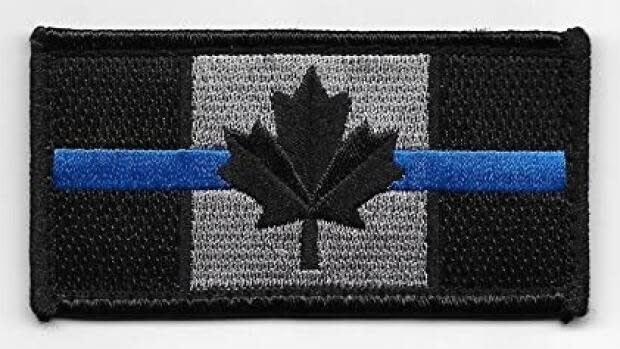Calgary police were directed to stop wearing thin blue line patches — but not pins

Less than a year after Calgary police were directed to stop wearing thin blue line patches, several officers were seen wearing pins with a horizontal blue line design during a protest outside a drag show on Sunday afternoon.
It prompted questions from the public about why police are permitted to keep the symbol on their uniforms.
Euan Thomson attended the counter-protest on Sunday and noticed the pins.
"I was under the impression that this had been put to bed, that we weren't going to see these pins or badges on officers' uniforms anymore," said Thomson.
"It betrayed trust — not only with the police force, but also with the police commission, who is supposed to be our oversight body for the police."
For some, the patch, which shows a thin blue line running through a depiction of the Canadian flag, is seen as a way to remember fallen officers. But the symbol has also become associated with white supremacy, an interpretation that led to the commission revoking approval of its use.
The pin, on the other hand, doesn't include the Canadian flag. It's a horizontal blue line, on a dark background, outlined in white.
Pins approved for wear, patches aren't
According to a statement from the Calgary Police Service (CPS), officers were asked to remove the thin blue line patch from uniforms before the end of last May — but the pin is still approved for wear.
The pin was approved in 2016, to recognize officers' length of service to frontline policing duties, said the statement.
"The approved patrol pin does include a thin blue line, but in a design that predates and differs from the Thin Blue Line patch that became a point of contention for community members who had seen that particular patch co-opted by hate organizations in both the U.S. and Canada," said the statement.

The officer in the recent social media post wasn't in breach of any policy, said the statement.
A statement from Calgary Police Commission says it didn't revoke the approval of the pins when it directed officers to stop wearing the patch.
"The Commission acknowledges that the pins also have the mixed messaging of a thin blue line."
'The message is different'
Doug King, a justice studies professor at Mount Royal University, says he had a big problem with the patch and previously wrote to the police commission about its history.
"I don't see the same problems with this pin that were with the patch," said King. "I think the message is different. I think the medium is different."
The symbolism of the patch was rooted in the depiction of the Canadian flag with the blue line through it, he says, and its audience was outside of policing. But he says that isn't the case with the pin.
"It's a blue line, right? It's not a blue line through anything," he said. "On the face of it, I don't see anything wrong with the pin."


